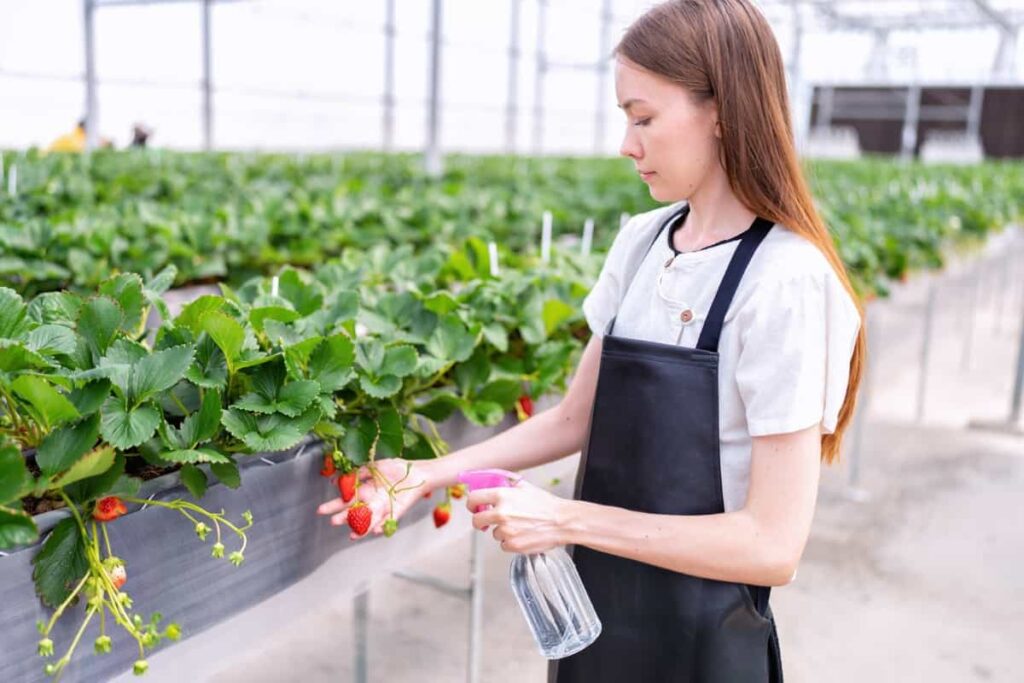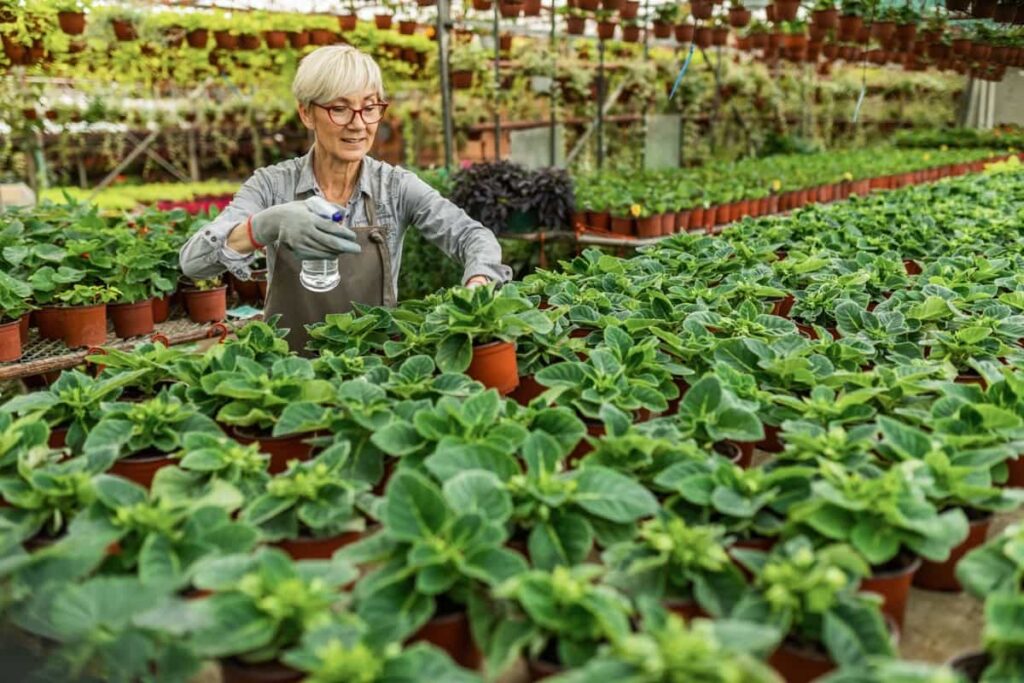Pests and diseases in commercial nurseries can have a major impact on commercial nurseries, affecting both the plants and the overall business. When pests invade a nursery, they feed on plant tissues, causing damage to leaves, stems, and even roots. This can weaken the nursery plants and make them more susceptible to other diseases. Identifying and managing these problems is crucial for maintaining a successful nursery operation.

How to Manage Pests and Diseases in Commercial Nurseries
Integrated Pest Management Strategies for Commercial Nurseries
Integrated Pest Management (IPM) is the main approach to managing pests in commercial nurseries. IPM strategies involve careful monitoring and identification of pests and diseases in nurseries, as well as implementing a combination of biological control methods, cultural practices, and targeted chemical treatments.
The most important pests in commercial nurseries are aphids, whiteflies, Fungal diseases like powdery mildew, Nematodes, and viruses, which can devastate an entire crop by causing discoloration, necrosis, and distortion of leaves. The important aspect of IPM is regular monitoring of plants for signs of pest infestation or disease. By regularly checking plants, nurseries can identify early signs of infestation and take appropriate action before the problem becomes widespread.
Biological Control Methods for Plant Pests in Nurseries
The common biological control method is the introduction of beneficial insects like ladybugs or lacewings that feed on aphids and other harmful pests. These insects can be released into the nursery environment, where they will naturally seek out and consume their prey. Another effective strategy is using nematodes, microscopic worms that target specific soil-dwelling pests such as root weevils or fungus gnats. These can be applied to the soil, where they infect and kill the targeted pests without harming desirable plants.
Chemical Control Measures for Managing Nursery Pests
The common chemical control method is the use of insecticides. These products are applied to kill or repel insects that may cause damage to nursery plants. There are various types of insecticides available, including contact sprays, systemic treatments, and baits. It’s essential to choose the right kind for your specific pest problem.
Another chemical control measure is the use of fungicides. Fungal diseases can wreak havoc on nursery plants if left untreated. Fungicides work by inhibiting or killing fungi that cause these diseases. Like insecticides, there are different types of fungicides available depending on the specific fungal issue you’re dealing with.
Preventive Measures to Minimize Disease Spread in Commercial Nurseries
Strict sanitation practices should be followed to prevent disease transmission. This includes regularly cleaning tools, equipment, and surfaces to remove any potential pathogens. Additionally, proper disposal of infected plant material is essential to avoid contamination. Maintaining good air circulation in the nursery is vital. Proper ventilation helps reduce humidity levels that can contribute to fungal diseases.
In case you missed it: Best Plant Nurseries in Kerala: For Indoor, Outdoor Garden Wholesale Centers, and Online Delivery

Adequate spacing between plants also allows for better airflow and reduces the risk of disease spread. Furthermore, it’s important to practice crop rotation and diversification to minimize disease outbreaks. Growing different plant species or varieties in rotation helps break the pest life cycle that may target specific crops.
Effective Monitoring Techniques for Plant Pests and Diseases
The effective technique is visual inspection. Observing plants closely allows for the identification of physical symptoms such as wilting leaves, discoloration, or the presence of insects. Regularly inspecting different parts of the nursery helps to catch signs of pest or disease infestation before it becomes widespread. Using sticky cards is another useful technique for monitoring flying insect pests like whiteflies or aphids. These cards coated with adhesive substances trap insects when they come into contact with them, allowing growers to assess pest populations accurately.
Implement Cultural Practices to Prevent Pest Infestations
The important cultural practice is proper sanitation. This includes regularly cleaning tools, equipment, and greenhouse structures to remove any potential hiding places for pests. Removing weeds and plant debris also helps eliminate habitats where pests can thrive. Crop rotation is another effective strategy. By rotating crops within nursery beds or fields, we disrupt the life cycles of pests that are specific to certain plant species.
This reduces their numbers over time and minimizes the risk of infestation. Plant selection plays a crucial role as well. Choosing resistant varieties or cultivars that are less susceptible to common pests can greatly reduce the need for chemical interventions. Additionally, spacing plants properly allows for good air circulation, making it harder for diseases to spread.
Practicing good irrigation techniques can also deter pest problems. Overwatering creates moist conditions that attract fungus gnats and other moisture-loving insects. Employing drip irrigation systems instead of overhead watering methods helps keep foliage dry, preventing fungal infections.
Utilize Beneficial Insects for Pest Management in Nurseries
Ladybugs are beneficial insects that can be introduced into nurseries. They feed on aphids, mites, and other soft-bodied pests that commonly infest plants. By releasing ladybugs strategically throughout your nursery, you can establish a natural predator-prey balance and keep pest numbers under control. Another useful insect for pest management is the green lacewing.
Green lacewings are particularly effective against spider mites, which can wreak havoc on nursery crops if left unchecked. Parasitic wasps are another group of beneficial insects commonly used in nurseries. These wasps lay their eggs inside or on top of harmful insect pests like whiteflies or caterpillars. As the wasp larvae develop within the host pests’ bodies, they ultimately kill them off without causing harm to the plants themselves.
Manage Fungal Diseases in Commercial Nursery Settings
Fungal diseases can wreak havoc on commercial nurseries, causing significant damage to plants and impacting the overall productivity of the operation. To manage fungal diseases in nurseries, it is crucial to implement preventive measures such as maintaining proper sanitation practices.
In case you missed it: 20 Best Plant Nurseries in Manila: Wholesale Garden Centers for Flowers, Fruits, Indoor, and Outdoor Plants

This includes regularly cleaning tools and equipment, removing infected plant material promptly, and avoiding overcrowding of plants, which can create favorable conditions for disease development. Managing fungal diseases in commercial nurseries requires a comprehensive approach combining prevention strategies with cultural practices, chemical treatments, biological controls where applicable, and close monitoring throughout all stages.
Control Viral and Bacterial Diseases in Nursery Environments
Viral and bacterial diseases can wreak havoc on commercial nurseries, impacting the health and productivity of plants. These microscopic intruders can spread rapidly, causing widespread damage and potentially leading to significant financial losses. It’s crucial to implement strict hygiene practices. Regularly clean all tools, equipment, and surfaces to minimize the risk of disease transmission. Additionally, ensure that employees follow proper sanitation procedures when handling plants or working in affected areas. Utilizing resistant plant varieties is another effective approach.
Develop a Pest and Disease Management Plan for Nurseries
Identify potential risks: Assess the specific pest and disease risks that are prevalent in your region, or that may be associated with particular plant species you grow. Understanding these problems will help you determine the most effective control methods.
Implement preventive measures: Minimize the risk of pest infestations by implementing good cultural practices such as proper sanitation, regular inspections, quarantine procedures for new plants or materials entering the nursery, and maintaining optimal growing conditions.
Monitor regularly: Establish a system for ongoing monitoring of plants to detect any signs of pests or diseases early on. This can include visual inspections, trapping techniques, sticky cards, or pheromone traps, depending on the type of pests you’re dealing with.
In case you missed it: 10 Best Compost Brands for Flowering Plants in India: Organic, Natural, and Quality Compost Brands

Implement corrective actions promptly: If any signs of infestation/disease outbreak are detected, take immediate action utilizing appropriate control measures from the IPM strategy.
Frequently Asked Questions (FAQ) on Pest and Disease Management in Nurseries
What are The Most Common Pests Found in Commercial Nurseries?
In commercial nurseries, you’re likely to encounter a different variety of pests that can wreak havoc on your plants. The most common pests affecting nursery plants include aphids, whiteflies, spider mites, thrips, and fungus gnats. These tiny creatures may seem harmless individually, but they can multiply rapidly and cause extensive damage if left unchecked.
How Can I Identify Plant Diseases in My Nursery?
Identifying plant pests and diseases is crucial for effective management. Keep an eye out for symptoms such as leaf spots, wilting or yellowing foliage, stunted growth, and abnormal discoloration.
How Often Should I Inspect My Plants for Signs of Pest Infestations or Disease Symptoms?
Regular monitoring is key – check your plants weekly at a minimum so you can detect any issues early on when they are easier to manage.
Conclusion
The presence of pests and diseases in a commercial nursery can lead to decreased crop yields and lower-quality produce. Infested or diseased plants may not grow as vigorously or produce optimal harvests. This directly impacts the profitability of the business. Nursery owners/managers must implement effective management strategies for maintaining healthy plant populations while minimizing losses due to these challenges.
- Management Pests and Diseases in Your Cotton Field
- Sheep Farming Business Plan for Beginners
- Aquaponic Farming at Home: A Step-By-Step Guide
- Profitable Village Farming Business Ideas in 2024
- High-Yield Aquaculture: Fast-Growing Fish for Farming
- Effective Fish Pond Construction Techniques for Beginners
- Irrigation and Water Management in Pineapple Farming
- Blossom to Harvest: Mastering Flowering and Pollination in Papaya Farming
- Pig Fattening Essentials: From Selection to Sale for Beginners
